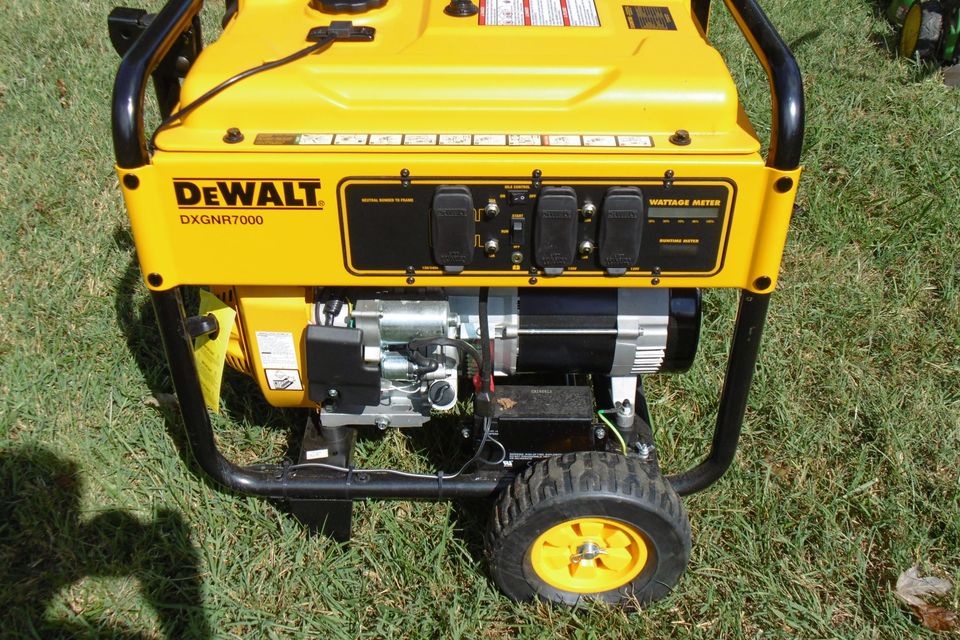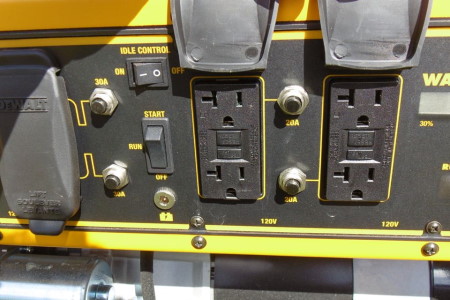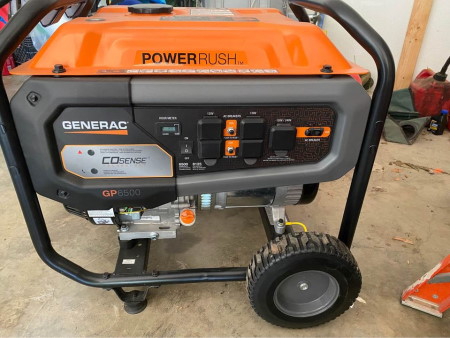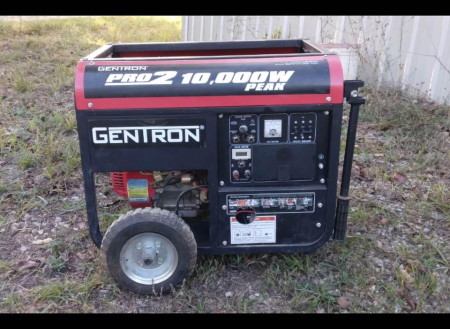
The bossman said you need to go work on that old barn. You are a long way from an electrical outlet, and you need a generator for your air compressor.
It’s time to pull out the portable generator.
Sizing a portable job site generator for your air compressor requires calculating how much of a load your equipment will pull, and then buying enough extra kilowatt capacity to allow for startup load.
An air compressor may be one of the larger pieces of equipment on a home builder’s job site, so it is a good tool to begin calculations with.
A small pancake air compressor would need a 3 kW generator (calculations below).
See Related: Over The Engine Creepers
Can A Portable Generator Run An Air Compressor?
You can get a generator to power any piece of equipment. It is all a matter of sizing the power output of the right generator to the load needs of the air compressor.
Air Compressor Startup Considerations

Construction tools pull more power on startup. During startup, they may pull up to 6 times the rated power for up to 3 seconds. An undersized generator will either not allow the tool to start, or will trip the breaker on your generator.
You need to take into account this inrush current on startup.
Continuing to power a tool with an undersized power source can cause premature motor failure.
To calculate startup motor requirements, you need to understand the common tool motor types
Universal
Simple tools like drills and circular saws use a universal motor. Universal motors require 2 times the run watts for their startup. You can calculate their power needs by multiplying volts times amps. Small pancake air compressors tend to use universal motors. Unless you have a 240-volt air compressor or a large 120-volt compressor with a capacitor-assisted startup, it is likely a universal motor and will draw 2 times the runtime voltage on startup.
Type G
Type G motors start around 5 horsepower and require a capacitor to assist their start. They are labeled on their nameplate as type G motors. Brick saws, large compressors, and table saws are examples of this category. Type G Capacitor start motors require 3 times the running watts for the startup.
Type L
Type L motors are the other common tool size motor. These start around 9 horsepower and need 6 times the running watts as inrush current for the startup. As with the Type G motors, these also use capacitors.
How To Calculate Generator Size
- Multiply volts times amperes to get the running watts.
- Multiply the running watts by 2 to get the starting watts. Use a higher multiple if it is a capacitor start motor.
- Choose a generator with a higher capacity than the calculated starting wattage.
Choosing The Right Size Generator To Run A Compressor

Easy Rule of Thumb: Buy 5 kilowatts of output per contractor using the generator.
Example: A C2002 Porter Cable pancake compressor uses only 10 amps at 120 volts, putting it at 1200 watts. The inrush current is twice that or 2,400 watts. A small 3,000 kW generator could power this one tool with ease.
Example: If a contractor wanted to run the C2002 Porter Cable compressor alongside a Dewalt DWS780 miter saw, we would need to also calculate the Dewalt’s inrush. The DWS780 is a larger, 15 amp motor with run watts of 120 volts x 15 amps = 1800 watts. Since this is also a universal motor, we only need 2 times the run watts, so this tool needs a 3,600-watt output generator. To start both tools at the same time, you would need a generator that can handle 6,000 watts (3,600 watts inrush saw + 2,400 watts inrush compressor).
However, if you are a solo operator, or have a construction who will coordinate the tool use, you could probably squeak by with a 5-kilowatt generator.
Conservative Wattage Calculation: You can find this lower number by calculating the starting load of the largest tool and adding that to the running load of all the other tools that might be running at the same time.
Generous Wattage Calculation: Calculate the starting load for all of the tools if they were to start simultaneously.
ProTip: stagger your equipment starts to preserve the life of your generator.
Using Your Contractor Generator For Camping And Tailgating

The entire reason we become contractors is so we can buy cool tools and use them on the weekend, right? Will this generator also work for your RV?
Your recreation vehicle has both resistive and motor loads. A resistive load would be something with a coil that heats, such as your electric hot water heater or an electric heat strip in your rooftop blower. Some portable coolers will use a small resistive load.
Motor loads would be everything else including your water pump and refrigerator.
To get an accurate calculation, you’ll want to read the power plates on all of your appliances and calculate the loads with an additional 50% to make sure you have enough for startup loads. In most cases, a 12 kW generator will suffice, with small RVs only needing about 4 kW.
Keep in mind air conditioners tend to have the largest starting requirements with 6 times inrush current.
What Size Generator Is Needed For a 2 HP Compressor?
The easy calculation is that 1 horsepower electric motors equal 746 watts draw (specifically 745.699872 watts).
So a 2 horsepower air compressor would draw approximately 2 x 746 watts = 1492 watts.
You would still want to account for the 2x inrush current required for startup. So a 3-kilowatt portable generator would be large enough to power a 2 horsepower air compressor.
Some motors will have running wattage and startup wattage printed on a metal nameplate.
Compressors with motors larger than 2 horsepower, will likely require a 240-volt electricity source. A 5 horsepower compressor would likely need at least a 12-kilowatt generator to power it.
Manual Transfer Switch
If you are powering a 240-volt compressor, connecting the generator to the shop and using a manual transfer switch to transfer the power through existing wiring can reduce the need for extension cords. This is helpful for high-load situations where you can take advantage of existing household or shop wiring. A transfer switch provides the added protection of running the power through a circuit breaker.
When Is a Generator Worth The Investment?

I’ve always found that generators are a hassle and I never use mine as much as I think I will.
That said, if you frequently work in any of the following circumstances, it might make sense to invest in a generator
Outdoor Work: If you are frequently building fences in large yards, it would make sense to have portable generators that can keep your crew running.
Power Outage: If it is critical that your team hits their targets even when there are power outages, it would make more sense to spend the money on standby generators.
Greater Power Requirements: I’ve been on construction sites where all of the crews are fighting for the same 15 amp line. Having your own power supply lets you skip the wait and get right to work.
How Do I Reduce The Power Consumption Of My Air Compressor?
Stop Leaks: Compressed air escaping through chucks and hoses will drive up your costs by requiring the compressor to engage more frequently and make up the differences.
Adjust Tool Settings: Most tools can be adjusted down to a lower spray setting or to where less air is used per trigger pull. Find the correct setting that gets the job done without wasted air.
Clean Air Filters: A clean air supply reduces the load and therefore improves the efficiency of the compressor.
 Skip to content
Skip to content

